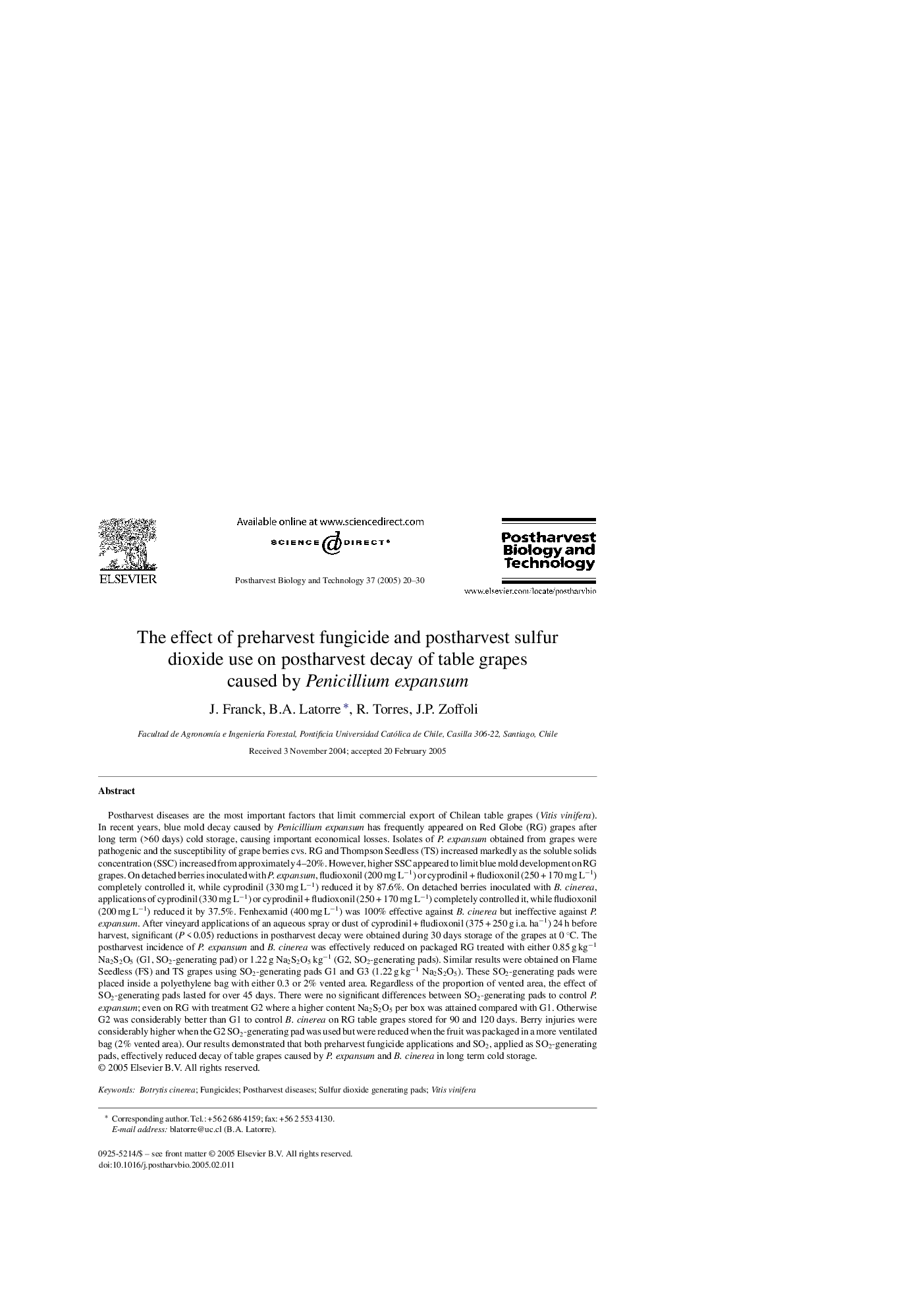| کد مقاله | کد نشریه | سال انتشار | مقاله انگلیسی | نسخه تمام متن |
|---|---|---|---|---|
| 9475177 | 1322875 | 2005 | 11 صفحه PDF | دانلود رایگان |
عنوان انگلیسی مقاله ISI
The effect of preharvest fungicide and postharvest sulfur dioxide use on postharvest decay of table grapes caused by Penicillium expansum
دانلود مقاله + سفارش ترجمه
دانلود مقاله ISI انگلیسی
رایگان برای ایرانیان
کلمات کلیدی
موضوعات مرتبط
علوم زیستی و بیوفناوری
علوم کشاورزی و بیولوژیک
علوم زراعت و اصلاح نباتات
پیش نمایش صفحه اول مقاله

چکیده انگلیسی
Postharvest diseases are the most important factors that limit commercial export of Chilean table grapes (Vitis vinifera). In recent years, blue mold decay caused by Penicillium expansum has frequently appeared on Red Globe (RG) grapes after long term (>60 days) cold storage, causing important economical losses. Isolates of P. expansum obtained from grapes were pathogenic and the susceptibility of grape berries cvs. RG and Thompson Seedless (TS) increased markedly as the soluble solids concentration (SSC) increased from approximately 4-20%. However, higher SSC appeared to limit blue mold development on RG grapes. On detached berries inoculated with P. expansum, fludioxonil (200 mg Lâ1) or cyprodinil + fludioxonil (250 + 170 mg Lâ1) completely controlled it, while cyprodinil (330 mg Lâ1) reduced it by 87.6%. On detached berries inoculated with B. cinerea, applications of cyprodinil (330 mg Lâ1) or cyprodinil + fludioxonil (250 + 170 mg Lâ1) completely controlled it, while fludioxonil (200 mg Lâ1) reduced it by 37.5%. Fenhexamid (400 mg Lâ1) was 100% effective against B. cinerea but ineffective against P. expansum. After vineyard applications of an aqueous spray or dust of cyprodinil + fludioxonil (375 + 250 g i.a. haâ1) 24 h before harvest, significant (P < 0.05) reductions in postharvest decay were obtained during 30 days storage of the grapes at 0 °C. The postharvest incidence of P. expansum and B. cinerea was effectively reduced on packaged RG treated with either 0.85 g kgâ1 Na2S2O5 (G1, SO2-generating pad) or 1.22 g Na2S2O5 kgâ1 (G2, SO2-generating pads). Similar results were obtained on Flame Seedless (FS) and TS grapes using SO2-generating pads G1 and G3 (1.22 g kgâ1 Na2S2O5). These SO2-generating pads were placed inside a polyethylene bag with either 0.3 or 2% vented area. Regardless of the proportion of vented area, the effect of SO2-generating pads lasted for over 45 days. There were no significant differences between SO2-generating pads to control P. expansum; even on RG with treatment G2 where a higher content Na2S2O5 per box was attained compared with G1. Otherwise G2 was considerably better than G1 to control B. cinerea on RG table grapes stored for 90 and 120 days. Berry injuries were considerably higher when the G2 SO2-generating pad was used but were reduced when the fruit was packaged in a more ventilated bag (2% vented area). Our results demonstrated that both preharvest fungicide applications and SO2, applied as SO2-generating pads, effectively reduced decay of table grapes caused by P. expansum and B. cinerea in long term cold storage.
ناشر
Database: Elsevier - ScienceDirect (ساینس دایرکت)
Journal: Postharvest Biology and Technology - Volume 37, Issue 1, July 2005, Pages 20-30
Journal: Postharvest Biology and Technology - Volume 37, Issue 1, July 2005, Pages 20-30
نویسندگان
J. Franck, B.A. Latorre, R. Torres, J.P. Zoffoli,